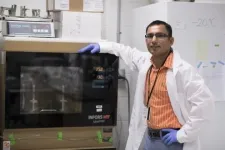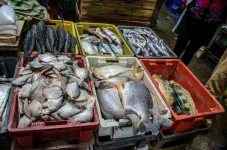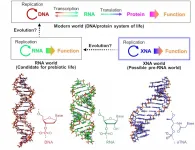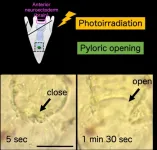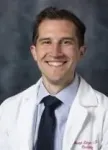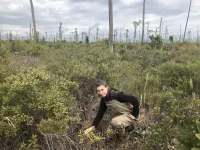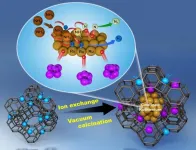(Press-News.org) DNA sequencing has become so common, few realize how hard it is to even extract a single molecule of DNA from a biological sample.
Research led by UC Riverside is making it easier to detect and capture DNA from fluid samples such as blood using a tiny glass tube and electric current. The technique, described in the journal, Nanoscale, can also improve cancer diagnosis in the future.
DNA, a double-stranded, electrically charged molecule that contains all the information an organism needs to create and organize the building blocks of life, is tightly folded within the cell nucleus. Extracting the DNA from a single cell is time consuming and impractical for many medical and scientific purposes. Fortunately, as cells die naturally, their membranes burst, releasing the contents, including DNA. This means that a blood sample, for example, contains many strands of free-floating DNA that should, in theory, be easier to identify and extract in quantity.
However, scavenger cells called macrophages that clean up cellular waste destroy most cell-free DNA, leaving it at low concentrations in the blood. Most approaches to capturing cell-free DNA require expensive techniques that first concentrate the molecules before using fluorescent dyes to help see the DNA.
Corresponding author Kevin Freedman, an assistant professor of bioengineering at UC Riverside's Marlan and Rosemary Bourns College of Engineering, led an effort to improve detection and capture of DNA at lower concentrations by using an electric charge to direct a DNA sample directly into a glass tube with a tiny opening called a nanopore. Nanopore sensing has emerged as a fast, reliable, and cost-effective diagnosis tool in different medical and clinical applications.
"We know that if you apply voltage across a cell membrane, ions will move through pores in the cell membrane," Freedman said. "DNA also travels with the electric field, and we can use it to move the DNA."
The researchers put a positive electrode inside a glass tube with an opening, or pore, 20 nanometers wide -- a bit bigger than a DNA molecule but too small to admit cells. They applied an electrical potential to the nanopore, which was dipped into a vial containing a DNA sample and a negative electrode. The cell-free DNA moved into the pore and blocked it. The change in electrical current as the DNA traveled through the pore allowed the researchers to detect it.
"It's like trying to pull spaghetti through a needle," Freedman said. "To go through the pore it has to be almost perfectly linear."
The closer to the liquid surface the researchers held the pore, the more DNA it picked up.
"Amazingly, we found that DNA accumulates at the liquid-air interfaces. If there is a cooling layer, the DNA will try to go to the cooler location," Freedman said. "We hope the same is true for a blood sample, so the same mechanism can be used to concentrate DNA near the surface. Not only is this beneficial, but this nanopore-sensing strategy demonstrated a higher signal-to-noise ratio near the surface as well. It is really a win-win situation."
With some refinements, the authors think their purely electric technique could help diagnose some kinds of cancer from a single blood sample. In addition to DNA, as tumors grow, vesicles are released into the blood stream. These mini lipid-based droplets can be thought of as mini-cells that are identical to the original cancer cells and could also be detected by nanopore sensing.
Considering all the unique features of this purely electrical technique, the nanopore-sensing system has the potential to be utilized as a point-of-care diagnostic test evaluation in the future.
INFORMATION:
Freedman was joined in the research by Nasim Farajpour, Lauren S. Lastra, and Vinay Sharma, all of whom are at UC Riverside. The paper, "Measuring trapped DNA at the liquid-air interface for enhanced single molecule sensing," is available here.
Bans on menthol cigarettes across Canada from 2016 to 2017 led to a significant increase in the number of smokers who attempted to quit, smokers who quit successfully, and lower rates of relapse among former smokers, according to a new research study from the International Tobacco Control Policy Evaluation Project (the ITC Project) at the University of Waterloo.
Menthol is the most common flavoring for cigarettes in many countries. Menthol creates a cooling sensation, which reduces the harshness of cigarette smoke. Because of this, menthol leads to increased experimentation and progression ...
New research from UVA Cancer Center could rescue once-promising immunotherapies for treating solid cancer tumors, such as ovarian, colon and triple-negative breast cancer, that ultimately failed in human clinical trials.
The research from Jogender Tushir-Singh, PhD, explains why the antibody approaches effectively killed cancer tumors in lab tests but proved ineffective in people. He found that the approaches had an unintended effect on the human immune system that potentially disabled the immune response they sought to enhance.
The new findings allowed Tushir-Singh to increase the approaches' effectiveness significantly in lab models, reducing tumor size and improving overall survival. The promising results suggest the renewed potential for the strategies in human patients, he and his ...
Seafood is a pillar of global food security--long recognized for its protein content. But research is highlighting a critical new link between the biodiversity of aquatic ecosystems and the micronutrient-rich seafood diets that help combat micronutrient deficiencies, or 'hidden hunger', in vulnerable populations.
"Getting the most nutritional value per gram of seafood is crucial in fighting hidden hunger and meeting United Nations Sustainable Development Goals," says Dr. Joey Bernhardt, an ecologist from the University of British Columbia (UBC) who led the study, published this week in the Proceedings of the National ...
Nagoya University scientists in Japan have demonstrated how DNA-like molecules could have come together as a precursor to the origins of life. The findings, published in the journal Nature Communications, not only suggest how life might have begun, but also have implications for the development of artificial life and biotechnology applications.
"The RNA world is widely thought to be a stage in the origin of life," says Nagoya University biomolecular engineer Keiji Murayama. "Before this stage, the pre-RNA world may have been based on molecules called xeno nucleic acids ...
Tsukuba, Japan - Many life forms use light as an important biological signal, including animals with visual and non-visual systems. But now, researchers from Japan have found that neuronal cells may have initially evolved to regulate digestion according to light information.
In a study published this month in BMC Biology, researchers from the University of Tsukuba have revealed that sea urchins use light to regulate the opening and closing of the pylorus, which is an important component of the digestive tract.
Light-dependent systems often rely on the activity of proteins in the Opsin family, and these are found across the animal kingdom, including in organisms with visual and non-visual systems. Understanding ...
LOS ANGELES (April 5, 2021) -- New research from the Smidt Heart Institute shows that more patients--specifically those with medical risk factors or from underserved communities--opted into telehealth appointments for their cardiovascular care during the COVID-19 pandemic. The data also suggests these telehealth patients underwent fewer diagnostic tests and received fewer medications than patients who saw their doctors in person.
The findings, published in JAMA (Journal of the American Medical Association) Network Open, point to "digital shifts" in cardiovascular care amid the ongoing COVID-19 pandemic.
"We were encouraged to learn that access to cardiovascular ...
DURHAM, N.C. -- Emily Ury remembers the first time she saw them. She was heading east from Columbia, North Carolina, on the flat, low-lying stretch of U.S. Highway 64 toward the Outer Banks. Sticking out of the marsh on one side of the road were not one but hundreds dead trees and stumps, the relic of a once-healthy forest that had been overrun by the inland creep of seawater.
"I was like, 'Whoa.' No leaves; no branches. The trees were literally just trunks. As far as the eye could see," said Ury, who recently earned a biology Ph.D. at Duke University working with professors Emily Bernhardt and Justin Wright.
In bottomlands throughout the U.S. East ...
Tsukuba, Japan - With a prevalence of about one in 10 people worldwide, chronic kidney disease (CKD) is a global health problem. It also often goes undetected, leading to a range of negative health outcomes, including death. Catching it at an early stage and adjusting nutrition and lifestyle can improve and extend life, but only if there are economically feasible systems in place to promote and educate on this.
Amid finite health-care resources, any CKD intervention must be both practical and cost-effective. A team of researchers centered at the University of Tsukuba now believe they have found a CKD behavioral intervention that can be delivered at a reasonable cost. They published their findings in the Journal of Renal Nutrition.
Changing eating and lifestyle habits, and ...
For the implementation of the effective hydrogen economy in the forthcoming years, hydrogen produced from sources like coal and petroleum must be transported from its production sites to the end user often over long distances and to achieve successful hydrogen trade between countries. Drs. Hyuntae Sohn and Changwon Yoon and their team at the Center for Hydrogen-fuel Cell Research of the Korea Institute of Science and Technology (KIST) have announced a novel nanometal catalyst, constituting 60% less *ruthenium (Ru), an expensive precious metal used to extract hydrogen via ammonia decomposition.
*Ruthenium is a metal with the atomic number 44, and is a hard, expensive, silvery-white member of the platinum group of elements.
Ammonia has recently emerged as a liquid storage and transport ...
Epidemiological studies have found that transportation noise increases the risk of cardiovascular morbidity and mortality, with high-quality evidence for ischaemic heart disease. According to the WHO, ?1.6 million healthy life-years are lost annually from traffic-related noise in Western Europe. Traffic noise at night causes fragmentation and shortening of sleep, elevation of stress hormone levels, and increased oxidative stress in the vasculature and the brain. These factors can promote vascular dysfunction, inflammation and hypertension, thereby elevating the risk of cardiovascular ...
